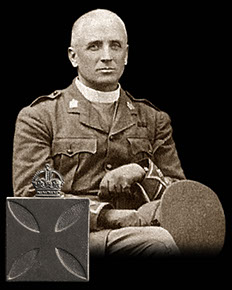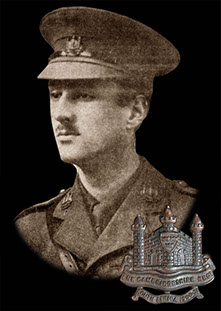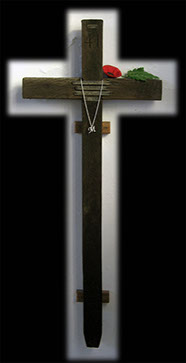The Padre and His Son
There are many instances of sons following their fathers into the Cambridgeshire Regiment, with the story of William Crookham and his son Hugh being one example.
Born in Norfolk, William Thomas Rupert Crookham took up Holy Orders, being appointed in 1889 as a curate in Balsall Heath, Birmingham, before moving to a parish in Brighton in 1892. Having married the daughter of Archdeacon Emery, the Dean of Ely Cathedral, he became rector of Haddenham, near Ely, from 1893 to 1905. While at Haddenham, the Rev Crookham was appointed acting chaplain to the 3rd (Volunteer) Btn, The Suffolk Regiment, in January 1899 and volunteered for service with that regiment’s Volunteer Contingent in the Boer War, seeing service in South Africa in 1900 and being awarded the Queen’s South Africa Medal.
He became vicar of St Peter and St Paul’s Church, Wisbech, in 1905 and was Rural Dean from 1907 to 1914. He had transferred from the Volunteers to the new Cambridgeshire Regiment in 1908 and was promoted to Chaplain 3rd Class (ranking as Major) in 1910 and 2nd Class (Lt-Col) in 1914.
The Rev Crookham served with the Cambridgeshires at home when the war was declared, but left England in January 1915 for a posting as senior chaplain with the Indian Expeditionary Force at the Suez Canal. Taken sick, he returned to England in August and became district senior chaplain for Eastern Command and senior chaplain to the British Forces during the Irish rebellion in Dublin in 1916. He ended the war as Colonel and principal chaplain of XXIII Corps. Made a CBE in the Birthday Honours of 1919, he also held the Territorial Decoration. After the war he was an honorary chaplain to the forces, Rural Dean of Wisbech from 1920-25, honorary canon of Ely Cathedral, and retired from St Peter’s, Wisbech, in 1932. Having moved to Milford on Sea, Hampshire, he died on December 20th, 1945.
His son Hugh Anthony Rupert Crookham was born in 1893 at Brighton and educated at The Knoll, Woburn Sands and Felsted School, Essex, where he was a member of its Officer Training Corps. He gained a scholarship to Jesus College, Cambridge, in 1912. After war was declared and while still a student, he took a commission in the Cambridgeshire Regiment in October 1914 and was posted to C Company in the new 2/1st Battalion. He became engaged to Miss Mary Ina Grace Disney, only daughter of the Rev William Disney, of Skegness, and a sister of a fellow 2/1st Battalion officer, Patrick Disney, who was also a Cambridge graduate.
As officer casualties began to mount in the 1/1st Battalion, Hugh was selected for posting overseas and sailed from Southampton on June 20th, 1915, arriving at Rouen the following day, and reaching the 1/1st Battalion in the Armentieres sector of France on June 25th, where he was posted to B Company, No 5 Platoon.
His time with the battalion was short, sustaining a fractured skull from the explosion of a German rifle grenade during the night of July 2/3rd while in Trench No. 86 at Nobbs Farm. Four of his men were wounded too.
Crookham was taken to 82nd Brigade Field Ambulance and had an operation, before being moved to a base hospital on the coast, where his mother visited him. He died of meningitis a month later on August 3rd, 1915, at the 3rd General Hospital, Le Treport, aged 22. During July he had been awarded his BA from Cambridge University by proxy. He is buried at Le Treport Military Cemetery; the original wooden cross from his grave is preserved in St Peter’s Church at Wisbech. Crookham’s name is recorded on the war memorials at Haddenham and Wisbech.
Wounded at the same time were four members of Crookham’s platoon: Pte George Gladstone Cook, of Cambridge, who was discharged from the army in 1919; Pte Charles Frederick Howard, of Chesterton, who died of wounds the same day and is buried at Cite Bonjean Military Cemetery; Pte Charles Stepney, of Cambridge, who was discharged from the army in 1916; and Pte Edgar Lewis Anderson, of Cambridge. Anderson went on to be awarded the Distinguished Conduct Medal for gallant conduct at Third Ypres in 1917, served as a city councillor in Cambridge from 1955-64 and died in 1969.

Rev. William Crookham in early 1915.

Hugh Crookham after joining the Cambs.

Hugh's IWGC grave marker now at St Peter's.

This site went live on the 14th February 2015 to mark 100 years since the 1/1st Cambs went off to war.
WE WILL REMEMBER THEM
Email us: cambsregt@gmail.com
Copyright 2015, 2016, 2017, 2018, 2019 by Felix Jackson. The information and images on this site should not be reproduced without prior permission.